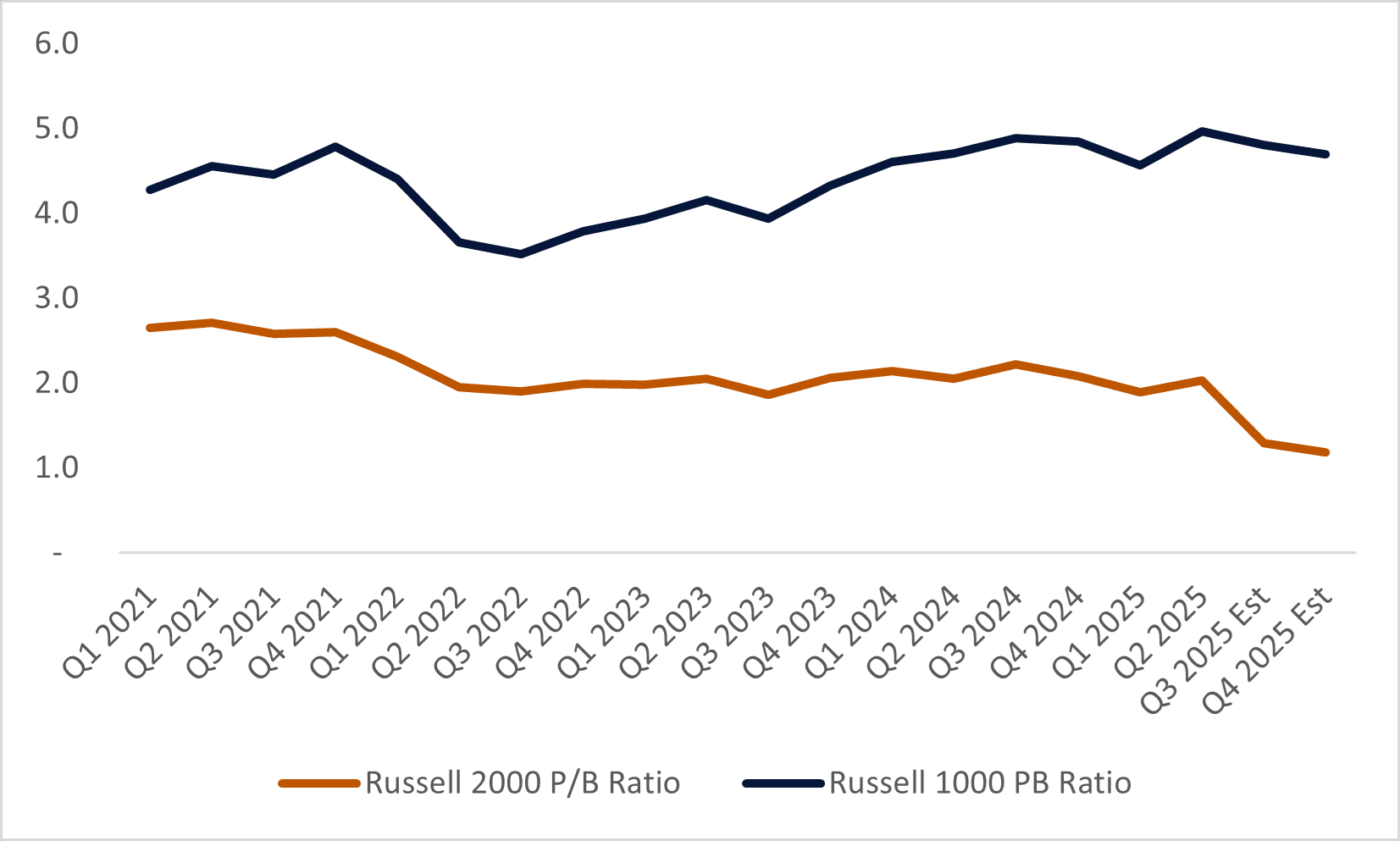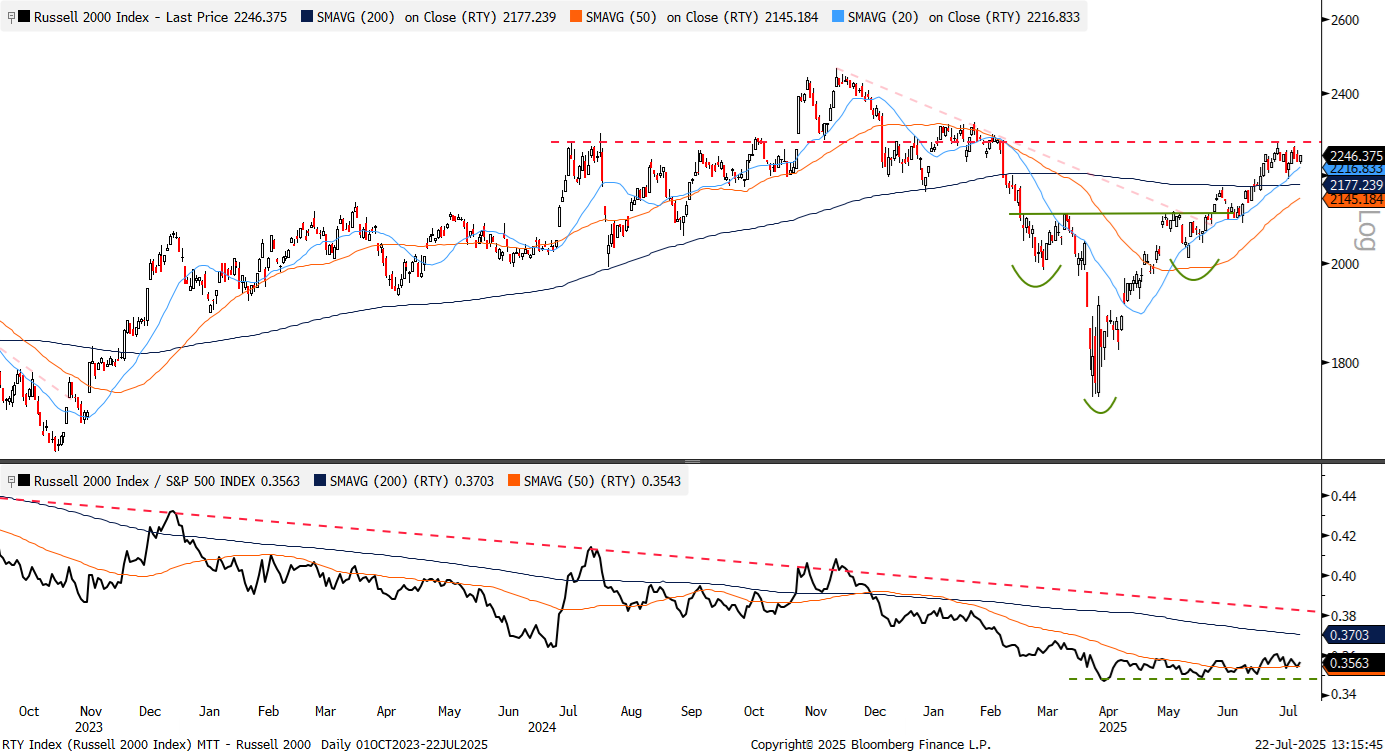Trump to impose 100% tariff on China starting November 1
Small cap equities remain one of the most paradoxical asset classes — frequently dismissed yet frequently cited as a contrarian buying opportunity on attractive valuations but often dissed by markets. This intrinsically intriguing enigma is rooted in certain market dynamics that are on full display right now. As such, we thought it would be appropriate to highlight key small cap themes that grant them both interest and an undertone of caution.
Tax Provisions in the One Big Beautiful Bill Act (OBBBA)
Beginning with tax years starting after December 31, 2024, businesses are once again permitted to fully deduct domestic research and development (R&D) expenses in the year they’re incurred. This includes expenditures related to software development, product innovation, and other qualifying R&D activities. This change effectively overturns the previous requirement to amortize such costs over a five-year period.

While the expense deduction is limited to U.S. based R&D, it should serve to significantly benefit smaller businesses, increasing the total amount of current deductions, decreasing tax bills, and thus increasing net profits to keep more immediate cash in the pockets of companies with heavy spending amounts. The increase in allowable deductions of interest costs and permanent 100% bonus depreciation for qualified purchases may also benefit small cap companies more than their larger counterparts.
Attractive Valuations
Over the past several quarters, we’ve witnessed a widening gap between large cap stock valuations relative to small caps, a trend that appears to be poised to continue through the next two quarters. This divergence is reflected in the price-to-book ratios (P/B): the Russell 1000 Index, which represents large cap equities, currently trades at a P/B of 5.35, while the Russell 2000, a benchmark for small cap stocks, sits at a much lower 2.03.
This growing disparity suggests that investors are paying more than twice as much for each dollar of book value in large cap stocks compared to their small cap counterparts. While this may reflect confidence in the earnings power and stability of large cap companies — especially those in tech and artificial intelligence (AI) — it also raises questions about valuation risk and future return potential.
As the premium on large caps continues to expand, small cap equities become increasingly attractive on a relative basis. Their lower valuations may signal undiscovered value or underappreciated growth potential, particularly in sectors poised to benefit from domestic policy tailwinds, such as reshoring, infrastructure investment, and small business tax incentives under the OBBBA. The “Relative Valuations Between Large and Small Caps Have Widened” chart highlights this valuation relationship and recent divergence.
Technical Analysis Trends
Small cap stocks have staged an impressive recovery off their April lows. The nearly 30% rally since April 8 has pushed the Russell 2000 out of a major bottom formation (technically labeled an inverse head-and-shoulders) and above its key moving averages. Based on the size of the prior pattern, a minimum technical-based price objective sets up near 2,480, coincidentally near resistance from the November 2024 highs (2,467). Participation in the recovery has been relatively widespread, although select breadth metrics suggest there is scope for further improvement. Leadership has also become cyclical, with technology and basic materials leading the charge higher, while utilities and consumer staples have significantly underperformed.
While the absolute trend for the Russell 2000 has turned higher, the same cannot be said about its relative trend, highlighted in the lower panel of the “Russell 2000 Price Action” chart. The Russell 2000 vs. S&P 500 ratio chart remains in a multi-year downtrend, indicative of small caps underperforming large caps. Given the improving technical backdrop for the index, we would not rule out a catch-up rally in small caps back toward the prior highs; however, until the relative trend turns higher, it is hard to make the case for sustainable small cap leadership ahead.
 Source: LPLFinancial, Bloomberg 07/21/25
Source: LPLFinancial, Bloomberg 07/21/25
Borrowing Landscape is Calm
For smaller companies, higher borrowing costs can be a significant hurdle to contend with. These companies largely rely on debt issuance to fund operations as extensive capital is required to fund business expansion. For now, credit conditions remain calm. We’ve seen historically tight credit spreads on corporate debt recently, meaning additional borrowing premiums for riskier loans are cost-efficient. The Bloomberg U.S. Aggregate Corporate Average Option-Adjusted Spread has been in a downward trajectory the past two years and sits around historical lows.
Intermediate-term interest rates have been rangebound for much of the year, while the baseline fed funds rate is expected to be cut by 0.25% at least once and possibly twice this year. Together, with easing baseline rates and placid, manageable, tack-on spreads, small cap companies could continue to benefit from the borrowing environment.
We must caveat, however, that economic weakness could be a catalyst for Federal Reserve (Fed) rate cuts. If weakness materializes, we could see spreads widen, negating the effects of lower baseline rates, not to mention slower economic activity, potentially causing corporate revenue to deteriorate.
Moreover, small caps tend to be more sensitive to domestic economic cycles, meaning they could outperform if the U.S. economy remains resilient or accelerates. For long-term investors, especially those with little exposure down the market cap spectrum, this valuation gap presents a compelling opportunity to rebalance portfolios toward small cap exposure — especially if mean reversion begins to take hold.
Potential Market Broadening
We’ve witnessed a meaningful rotation in market leadership so far in 2025. After a prolonged run, U.S. mega cap tech stocks have taken a breather, creating space for other areas to shine. Notably, European markets — including Germany, the U.K., and France — have delivered strong relative performance, reversing years of underperformance. Emerging markets have also gained traction, with Hong Kong and South Korea posting impressive gains. Non-U.S. small cap stocks have emerged as key beneficiaries of recent U.S. tariff policy as well.
This shift in leadership has been supported in part by continued weakness in the U.S. dollar, which enhances the appeal of non-U.S. assets.
As this broadening continues, small cap equities — particularly in the U.S. — stand to benefit. Their relative undervaluation, domestic focus, and sensitivity to economic growth position them well in an environment where capital is flowing beyond the usual large cap leaders. After a sharp decline in the dollar during the first half of the year, a short-term reversal of the greenback could also put domestic small caps in a more favorable position.
Conclusion
There’s currently an opaque confluence of data points revealing both renewed optimism and caution. We believe Fed rate cuts driven by easing inflation (instead of economic growth deterioration) could positively impact borrowing costs, and valuation models, though more so for small cap growth than small cap value. We’ll also be monitoring the technical landscape, as this gives us more direct insight into shorter-term opportunities. Breadth and signs of an improving relative trend will be on our radar.
Currently, in our tactical asset allocation, we hold a neutral weight to small cap growth, and a modest underweight to small cap value. While current valuations are compelling, sustained economic growth remains essential before we can gain confidence in companies with comparatively weaker balance sheets. Fiscal policy is incrementally supportive, but trade policy is a wild card.
***
Important Disclosures
This material is for general information only and is not intended to provide specific advice or recommendations for any individual. There is no assurance that the views or strategies discussed are suitable for all investors. To determine which investment(s) may be appropriate for you, please consult your financial professional prior to investing.
Investing involves risks including possible loss of principal. No investment strategy or risk management technique can guarantee return or eliminate risk.
